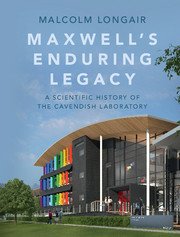Book contents
- Frontmatter
- Dedication
- Contents
- Preface
- Acknowledgements
- Part I To 1874
- Part II 1874 to 1879
- Part III 1879 to 1884
- 4 Rayleigh's quinquennium
- Part IV 1884 to 1919
- Part V 1919 to 1937
- Part VI 1938 to 1953
- Part VII 1953 to 1971
- Part VIII 1971 to 1982
- Part IX 1984 to 1995
- Part X 1995 to present
- Appendix The evolution of the New Museums site
- Notes
- References
- Author index
- Subject index
4 - Rayleigh's quinquennium
from Part III - 1879 to 1884
Published online by Cambridge University Press: 05 July 2016
- Frontmatter
- Dedication
- Contents
- Preface
- Acknowledgements
- Part I To 1874
- Part II 1874 to 1879
- Part III 1879 to 1884
- 4 Rayleigh's quinquennium
- Part IV 1884 to 1919
- Part V 1919 to 1937
- Part VI 1938 to 1953
- Part VII 1953 to 1971
- Part VIII 1971 to 1982
- Part IX 1984 to 1995
- Part X 1995 to present
- Appendix The evolution of the New Museums site
- Notes
- References
- Author index
- Subject index
Summary
Rayleigh's appointment
The original intention of the University was that the Cavendish Professorship should be a single-term appointment, but the wording of the regulations offered the possibility of extension of the position. It stated that the post was to
terminate with the tenure of office of the Professor first elected unless the University by Grace of the Senate shall decide that the Professorship shall be continued.
Again, Sir William Thomson was an obvious choice, but by now he saw his future in Glasgow. The next obvious candidate was John William Strutt, who had succeeded to the Barony as the 3rd Lord Rayleigh on the death of his father in 1873. It was not a common occurrence for a senior member of the aristocracy and major landowner to become a professional academic, but Rayleigh had already demonstrated outstanding ability in theoretical and experimental physics. He had been senior wrangler in 1865 and first Smith'sPrize winner. He had sought to improve his understanding of experimental physics, but there were limited opportunities. Fortunately, Stokes allowed Rayleigh to observe his experimental researches in his private laboratory and so he gained some familiarity with the challenges involved. By the time his name came forward as a candidate for the Cavendish Chair, he was already known for his explanation of the colour of the sky through the process of Rayleigh scattering, and he had already written profusely on a very wide range of topics in the physical sciences, including experimental researches carried out at the family home at Terling Place in Essex.
But there was more to it than simply academic prestige. The Rayleigh estates had made most of their earnings through the sale of wheat. With the opening up of the midwest American prairies for wheat production, the price of wheat had plummeted and made the Rayleigh estates unprofitable. The agricultural depression was to last for a number of years and so Rayleigh decided to change to dairy farming. In the late 1880s, ‘Lord Rayleigh'sDairies’ supplied milk for the capital (Rayleigh, 1924). Although not decisive in encouraging Rayleigh to put his name forward as a candidate for the Cavendish Chair, the appointment would certainly help the family weather the downturn in their fortunes.
- Type
- Chapter
- Information
- Maxwell's Enduring LegacyA Scientific History of the Cavendish Laboratory, pp. 79 - 94Publisher: Cambridge University PressPrint publication year: 2016



